01.02.2007
Corus Tournament in Wijk aan Zee: a Creative Survey (Rounds 11-12)
Round 11
P.Svidler (2728) – V.Topalov (2783) [B90]
1.e4 c5 2.¤f3 d6 3.d4 cxd4 4.¤xd4 ¤f6 5.¤c3 a6 6.Ґe3 e5 7.¤b3 Ґe6 8.Јd2 ¤bd7 9.0–0–0 Ґe7 10.f3 h5 11.ўb1 Јc7 12.Ґd3 b5
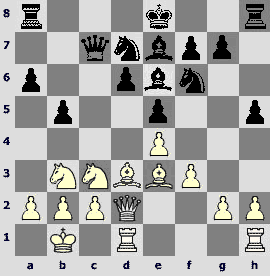
13.Ґg5. A novelty, in this way Peter brings pressure to bear on center.
13...¤b6 14.f4
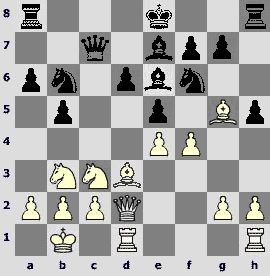
14...¦b8! The rook's rightful place is on b-file, as Black is going to disturb white king along this very line.
15.¦he1 ¤c4 16.Ґxc4 bxc4 17.¤c1 Јb7 18.b3 exf4. Black has opened the position of white monarch and prepared his own king's retreat to a safe haven.
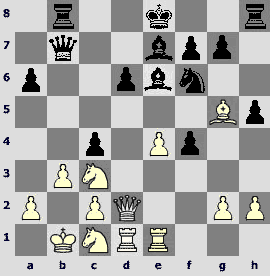
19.Ґxf4 0–0 20.Ґxd6 Ґxd6 21.Јxd6 ¦fc8 22.¤d5
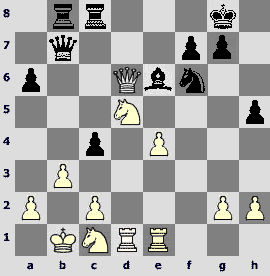
22...¤xd5! Fainthearted 22...Ґxd5 23.exd5 ¦d8 24.Јc6 permits White even to get some small advantage.
23.exd5 Ґf5 24.¦d2 Ґg6! A nook on h7 is ready for the king, and now White starts to get a real big thrashing. 25.¦e7 Јb5

26.¦c7? Loses, but I'd like to notice that to play such a position for White is an extremely unpleasant thing, on White's every move Black is capable of finding some new threat and attack.
26...Јa5 27.¦xc8+ ¦xc8 28.¦e2. 28.Јf4 c3 29.¦e2 Јxd5 leads to an enormous black advantage – the c1-knight practically cannot get into a fight, and white king is in danger as before.
28...cxb3 29.axb3 Јc3 30.Јg3 Ґxc2+ 31.ўa2 Ґb1+? Veselin supposes to mate in that way. In reality the easy way to win is 31...Јc5.
32.ўxb1 Јxc1+ 33.ўa2
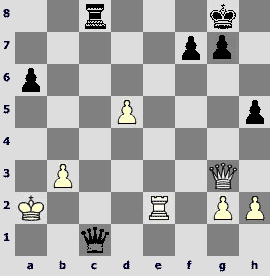
33...¦c5? Probably waiting for surrender... The right course is 33...¦c2+ 34.¦xc2 Јxc2+ 35.ўa3 Јc5+ with great chances to win.
34.Јb8+ ўh7 35.Јb4. The tables are turned, Black has no material for an attack left, and the white d5-pawn is not a weakness any more, but a formidable threat.
35...f5 36.Јd2 Јxd2+ 37.¦xd2 ўg6 38.b4 ¦c8 39.ўb3 ўf7 40.¦a2 ¦a8 41.h4! Black pawn advantage on the K-side is of no value any more.
41...f4
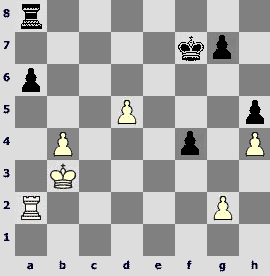
42.¦e2! A splendid move that wins the game! White cuts off the black king from the passed d-pawn.
42...ўf6?! More tenacious is 42...¦b8, but still after 43.ўc4 ¦c8+ 44.ўd4 ¦b8 45.d6 ¦xb4+ 46.ўd5 White is to win anyway.
43.ўc4 ¦c8+ 44.ўd4 ¦b8 45.d6 ¦xb4+ 46.ўc5 ¦b1 47.¦d2 ¦b8 48.d7 1–0
M.Carlsen (2690) – L.van Wely (2683) [B90]
1.e4 c5 2.¤f3 d6 3.d4 cxd4 4.¤xd4 ¤f6 5.¤c3 a6 6.Ґe3 e5 7.¤f3 Ґe7 8.Ґc4 0–0 9.Јd3 ¤c6 10.a3 b5 11.Ґd5 Јc7 12.Ґg5 Ґe6 13.Ґxf6 Ґxf6 14.0–0 ¦ac8 15.¦fd1 ¤d4 16.h3 g6 17.¦ac1 Ґg7 18.Јe3 Јb8 19.Јd3 Јc7
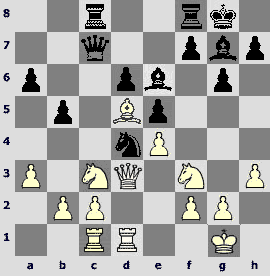
20.¤xd4? Rejecting the move repetition is not a good idea.
20...exd4 21.Ґxe6 fxe6 22.¤e2 Ґh6 23.¦b1 Јxc2 24.Јxc2 ¦xc2 25.¤xd4 ¦cxf2 26.¤xe6 ¦8f6 27.¦xd6 Ґe3 28.ўh1 ўf7 29.¤d8+ ўe7 30.¦xf6 ¦xf6 31.e5 ¦b6 32.¦d1 Ґf4 33.g4 Ґxe5 34.¦e1 ўf6 35.¦f1+ ўe7 36.¦e1 ўf6 37.¦f1+ ўg7 38.¦f7+ ўg8 39.b3 ¦d6 40.¦e7 Ґb2 41.¦e8+ ўg7 42.a4 ¦d3 43.axb5 axb5 44.ўg2 Ґf6 45.¤c6 ¦xb3 46.¦b8 h5 47.gxh5 gxh5

Young player manages to find a beautiful way to draw.
48.¤a7 b4 49.¤c6 Ґc3 50.¤xb4! Ґxb4
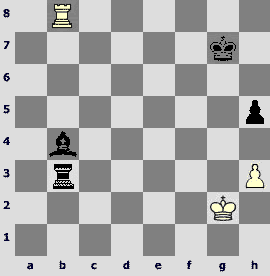
51.h4! Black cannot get rid of the pin without exchanging the rook or dropping the h-pawn. In both cases there is a theoretical draw.
51...ўf6 52.¦b5 ўg6 53.¦g5+ ўf6 54.¦b5 ўe6 55.¦xh5 Ґd6 56.¦g5 Ґf4 57.¦c5 Ґe5 58.h5 ¦g3+ 59.ўf1 ¦h3 60.ўe2 ўf5 61.h6 ўe4 62.¦c4+ Ґd4 63.¦c2 ¦xh6 64.¦d2 ¦h3 65.¦c2 Ґc3 66.ўd1 ўd4 67.¦f2 ўd3 68.¦d2+ ўc4 69.¦f2 ¦e3 70.¦e2 ¦d3+ 71.ўc2 Ґd4 72.¦d2 ¦a3 73.¦e2 Ґe3 74.ўd1 ¦a1+ 75.ўc2 ўd4 76.ўb2 ¦a8 77.ўb1 ¦h8 78.ўc2 ¦c8+ 79.ўb3 ўd3 80.¦b2 Ґd2 81.¦b1 ¦a8 82.¦b2 ¦a1 83.¦a2 ¦d1 84.¦c2 ¦a1 85.¦c3+ ўd4 86.¦c4+ ўd5 87.¦g4 Ґe3 88.ўc2 Ґd4 89.ўd3 ¦a3+ 90.ўe2 ўc4 91.¦g2 ¦h3 92.ўd2 ¦e3 93.¦e2 ¦a3 94.ўc2 Ґe3 95.ўb2 ўb4 96.ўb1 Ґd4 97.ўc2 ўc4 98.¦d2 Ґe3 99.¦e2 ¦b3 100.ўd1 ўd3 101.¦d2+ ўe4 102.ўc2 ¦b8 103.¦d3 Ґd4 104.¦d2 ¦c8+ 105.ўd1 Ґe3 106.¦c2 ¦f8 107.ўe2 ўd4 108.ўd1 ўd3 109.¦d2+ Ґxd2 Ѕ–Ѕ. Magnus Carlsen was amazingly staunch in defense.
L.Aronian (2744) – S.Kariakin (2678) [E05]
1.d4 ¤f6 2.c4 e6 3.g3 d5 4.¤f3 Ґe7 5.Ґg2 0–0 6.0–0 dxc4 7.Јc2 a6 8.Јxc4 b5 9.Јc2 Ґb7 10.Ґd2 ¦a7 11.¦c1 Ґe4 12.Јb3 ¤c6 13.e3 Јa8 14.Јd1 ¤b8 15.Ґa5
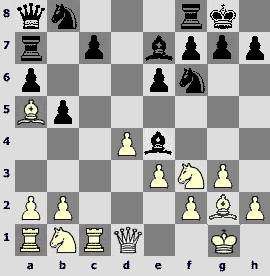
15...Ґd6! A self-evident strengthening in comparison with 15...¦c8, that has been employed twice during this tournament by Anand.
16.a3 ¤bd7 17.¤bd2 Ґd5. Black simple idea – on 18.b4 he will answer e6-e5 without unnecessary transferring the rook to c8 – becomes clear.
18.Јf1 c5. Black has managed to carry out c7-c5, but he is not free of problems still – White occupies the c-file.
19.dxc5 Ґxc5 20.¦c2 Јb7 21.¦ac1 Ґb6 22.Ґxb6 Јxb6 23.¤d4 ¤e5 24.Ґxd5 ¤xd5 25.¤4f3 ¤xf3+ 26.¤xf3 ¦d8 27.Јd3 ¤e7 28.Јe4 ¦ad7

29.ўg2! A classic way of strengthening the position. Black cannot become stronger, as there are no squares for the rooks to invade, and his knight is chained by the defense of the crucial c6-square, which White is prepared to invade in future. If the black pawn stood on b7 and not on b5, Black would have made a draw.
29...f6

30.h4! e5 31.h5 Јb7? Now the black queen is stuck on the Q-side, and the king is defenseless. The correct move is 31...Јe6, and Black retains good chances for a successful defense. Seriozha Kariakin has probably overestimated the pin on the f3-knight.
32.Јg4! ўf7 33.¦c5 ¦c8 34.¦xc8 ¤xc8
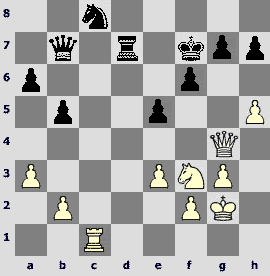
35.Јf5! Causing another weakening of the black king.
35...g6 36.Јg4 ¤e7 37.hxg6+ hxg6 38.¦h1 f5 39.¦h7+ ўe6 40.Јg5 Јe4 41.Јh6 f4 42.Јf8 ¤c6 43.Јc8 ¤e7 44.Јe8 ўd6 45.Јf8 Јd5 46.e4 Јe6 47.¤g5 1–0. A very skillfully played game. Levon has made the best use of his opponent's only inaccuracy (31...Јb7).
V.Kramnik (2766) – T.Radjabov (2729) [E92]
1.d4 ¤f6 2.c4 g6 3.¤c3 Ґg7 4.e4 d6 5.¤f3 0–0 6.Ґe2 e5 7.Ґe3 ¤g4 8.Ґg5 f6 9.Ґh4 g5 10.Ґg3 ¤h6 11.d5 ¤d7 12.¤d2 f5 13.exf5 ¤f6

14.Ґd3. Usually the game goes on like this: 14.¤de4 ¤xe4 15.¤xe4 Ґxf5 16.Ґd3 g4, and Black has counterplay sufficient for the equality due to the unfortunately positioned g3-bishop. Vladimir's last move is a novelty with an idea of preventing the above-mentioned construction that leaves the g3-bishop out of play.
14...¤xf5. The exchange of light-squared bishops is advantageous to White, so Black takes on f5 with his knight. However it is so well situated there that it would be unjust for Black to complain.
15.¤de4 Ґh6! 16.0–0 ўh8!
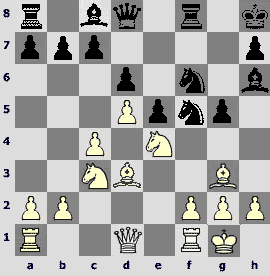
Black has arranged his pieces just wonderfully and now aims to carry out g5-g4 – he has an excellent play.
17.c5 g4 18.¤xf6 Јxf6 19.¤b5 Јe7 20.Јe2
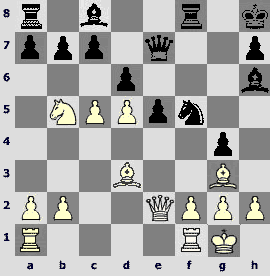
20...Ґg7!? There is a threat of h7-h5-h4, but it presupposes the pawn sacrifice. More natural is 20...a6 21.Ґxf5 ¦xf5 (but not 21...Ґxf5 22.cxd6 cxd6 23.¤xd6) 22.cxd6 cxd6 23.¤c3 with complex approximately even struggle.
21.cxd6 cxd6 22.Јxg4 ¤xg3 23.Јxg3 Ґd7 24.¤c7. A cautious decision, it was possible to keep the pawn 24.¤c3 Ґh6 25.Ґe4, although Black is not without compensation.
24...¦ac8 25.¤e6 Ґxe6 26.dxe6 Јxe6 27.¦ad1 d5 28.Ґb1 ¦cd8 Ѕ–Ѕ. The final position seems preferable for Black.
V.Anand (2779) – A.Shirov (2715) [C43]
1.e4 e5 2.¤f3 ¤f6 3.d4 ¤xe4 4.Ґd3 d5 5.¤xe5 ¤d7 6.¤xd7 Ґxd7 7.0–0 Ґd6 8.c4 c6 9.cxd5 cxd5 10.¤c3 ¤xc3 11.bxc3 0–0 12.Јh5 g6 13.Јxd5 Јc7 14.c4 Ґe6. An alternate way is 14...Ґxh2+ 15.ўh1 Ґc6 16.Јg5 Ґd6 17.d5 ¦ae8 18.f4 f6 19.Јg3 Ґd7 20.Ґxg6 hxg6 21.Јxg6+ with a draw (Motylev – Kramnik, Moscow 2005).
15.Јf3 Ґxc4 16.Ґh6 ¦fd8 17.¦fc1 b5 18.a4 Јe7 19.Ґxc4 bxc4 20.¦xc4

Black's compensation for the pawn appears minimal; nevertheless Alexey Shirov manages to draw confidently.
20...Јh4 21.Јh3 Јxh3 22.gxh3 ¦ac8 23.¦ac1. An attempt to invade the black camp along the b-file is not successful: 23.¦xc8 ¦xc8 24.¦b1 f5! 25.¦b7 ¦c7 26.¦xc7 Ґxc7. Strange as it may seem the bishop ending is drawish.
23...¦xc4 24.¦xc4 f5 25.Ґd2 ўf7 26.¦c6 ¦d7 27.ўg2 Ґe7 28.Ґc3 Ґd8 29.¦a6 Ґf6 30.ўf3 Ґxd4
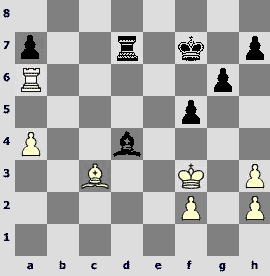
Ѕ–Ѕ
D.Navara (2719) – A.Motylev (2647) [D18]
1.d4 d5 2.c4 c6 3.¤c3 ¤f6 4.¤f3 dxc4 5.a4 Ґf5 6.e3 e6 7.Ґxc4 Ґb4 8.¤e5. A rare move.
8...¤bd7 9.¤xd7 Јxd7 10.0–0 0–0 11.f3 ¦fd8 12.Јb3 Јe7 13.¦d1 Ґg6 14.e4 e5 15.¤e2 exd4 16.¤xd4 Ґc5 17.Ґe3
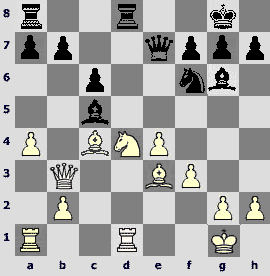
17...Ґxe4!! Seems evident, but looks so very striking anyway. The only thing I cannot understand is what has David Navara reckoned on when he agreed to this position? On Sasha Motylev's leaving his bishop on g6 and loosing meekly?
18.fxe4 ¤g4 19.ўh1 Јxe4 20.Ґxf7+ ўh8
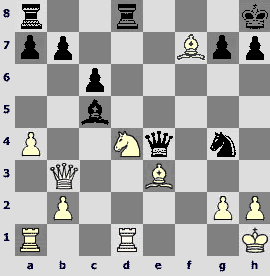
21.Јe6! Salvation must be sought in the endgame and only in the endgame.
21...Јxe3 22.Јxg4 Ґxd4 23.¦a3 Јe7 24.Јh5 ¦d6 25.¦ad3 c5 26.Ґc4. White pawn-and-bishop formation on the Q-side is really strong.
26...¦h6 27.Јg4 ¦f8 28.¦f3 ¦hf6 29.¦xf6 ¦xf6 30.b3 g6 31.h3 ўg7 32.Јe2

32...Јxe2?! Keeping the queens on the board retains some small winning chances; it would be better to play 32...Јd6, aiming at g3.
33.Ґxe2 ¦e6 34.Ґc4 ¦e7 35.g4 b6 36.ўg2 h5 37.gxh5 gxh5 38.¦f1 ўg6 39.Ґd3+ ўg7 40.ўg3 ўh6 41.¦f5 Ґc3 42.Ґc4 ўg6 Ѕ–Ѕ
R.Ponomariov (2723) – S. Tiviakov (2667) [B35]
1.e4 c5 2.¤f3 ¤c6 3.d4 cxd4 4.¤xd4 g6 5.¤c3 Ґg7 6.Ґe3 ¤f6 7.Ґc4 0–0 8.Ґb3 a5 9.f3 d5 10.Ґxd5 ¤xd5 11.exd5 ¤b4 12.¤de2 e6 13.a3 ¤xd5 14.¤xd5 exd5 15.Ґd4 Ґh6 16.0–0 ¦e8
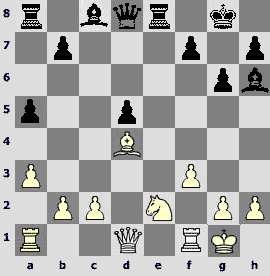
17.ўh1. A novelty but it's nothing here to write home about really; it's just another move. In theory this position has been estimated as level before it, and this move is not going to change this point of view. The main thing for Black is to avoid exchanging the dark-squared bishops.
17...Јh4 18.Ґf2 Јc4 19.¤d4 Ґd7 20.¦e1 ¦ac8 21.c3 ¦xe1+ 22.Јxe1 ¦e8 23.Јd1 b5 24.Ґg1 Ґf4 25.Јc2 h5 26.h3 Ґh6 27.Јd1 Ѕ–Ѕ
Round 12
S.Kariakin (2678) – M.Carlsen (2690) [C83]
1.e4 e5 2.¤f3 ¤c6 3.Ґb5 a6 4.Ґa4 ¤f6 5.0–0 ¤xe4 6.d4 b5 7.Ґb3 d5 8.dxe5 Ґe6 9.¤bd2 Ґe7 10.c3 0–0 11.Ґc2 f5 12.¤b3 Јd7 13.¤bd4 ¤xd4 14.¤xd4 c5 15.¤xe6 Јxe6 16.f3 ¤g5 17.a4 ¦ad8 18.axb5 axb5 19.Ґxg5 Ґxg5 20.f4 Ґe7 21.ўh1 ўh8 22.Јd3 Јb6 23.g4
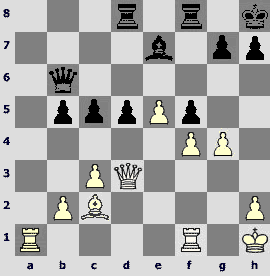
23...c4. A novelty, earlier occurred 23...d4 24.gxf5 c4 25.Јe4 d3 26.Ґd1 with white advantage (Fedorov – Delchev, 2006).
24.Јh3 Јc6 25.Јg2 fxg4 26.f5
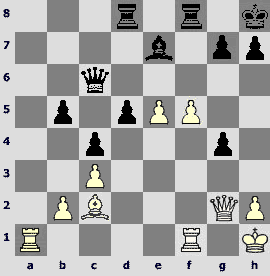
26...Ґc5? In order to solve his problems Magnus has to find an elegant move 26...g3!!, which eliminates the white pieces' hegemony over light squares and makes them use the dark squares as well.
27.Јxg4 ¦de8
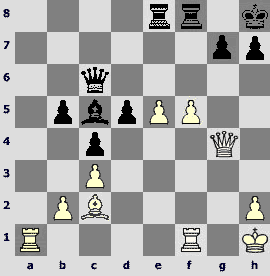
28.f6! A strong natural move. 28...gxf6
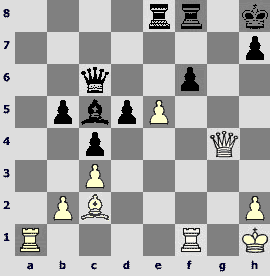
29.Ґxh7! A splendid blow! 29...¦xe5 30.Ґf5. One must be either a Kasparov or a computer to find a preliminary move 30.Ґg6!!, which at first entices the queen on b7, and only after 30...Јb7 there follows 31.Ґf5!. Maybe Topalov or Anand could have calculated this variation as well. As for now Seriozha Kariakin's level is not high enough for that, but I thing that he has every chance to catch up with the leaders and then leave them all behind.
30...¦f7. Black is just plain lucky to find a defense.
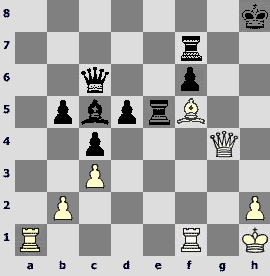
31.¦ae1. Again the strongest move is absolutely not evident: 31.¦fe1!! d4+ 32.Ґe4 ¦xe4 33.¦xe4 d3 34.Јg2 ¦h7 35.¦f1 Ґf8 36.¦f5, and White has a great, probably decisive advantage.
31...d4+ 32.Ґe4 Јe6 33.Ґf5 Јc6+ 34.Ґe4 Јe6 35.Ґf5 Јc6+ Ѕ–Ѕ. It is a real pity that Seriozha Kariakin has failed to win this beautiful game.
D.Navara (2719) – R.Ponomariov (2723) [C07]
1.e4 e6 2.d4 d5 3.¤d2 c5 4.¤gf3 ¤f6 5.exd5 ¤xd5 6.¤b3 ¤d7
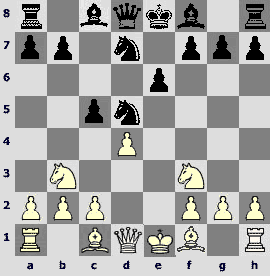
7.g3! White frequently uses the bishop's fianchetto against the Exchange Variation of the French defense - a very sound positional idea.
7...Ґe7 8.dxc5 ¤xc5 9.Ґg2 0–0 10.0–0 Јb6. It surely is better to hold on to the d5-square like grim death, and the move 10...b5 would have contributed to this, but black position is unpleasant anyway.
11.c4 ¤xb3
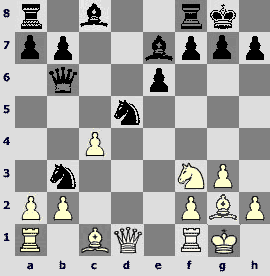
12.Јxb3! In the endgame the advantage becomes especially great – White manages to exchange the queen that used to defend the b7-pawn. Now the pawn is left defenseless, as it is impossible for Black to develop his light-colored bishop in a more or less normal way.
12...Јxb3 13.axb3 ¤b4 14.Ґe3 a6 15.Ґb6 Ґd7. More tenacious is 15...f6, although after 16.¤d4 e5 17.¤b5 White has great advantage.
16.¤e5 Ґc6
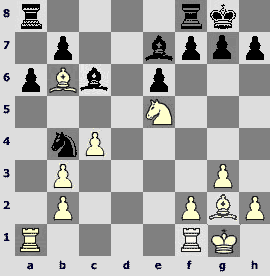
17.¦fd1! Capturing both bishops would be premature – 17.¤xc6 bxc6!, and Black has very good chances to draw.
17...Ґxg2 18.ўxg2 f6 19.¦d7! ¦ae8 20.¤f3. Black is pawn down without any compensation, and White has only to be accurate to utilize his advantage.
20...¦f7 21.¦xb7 Ґf8 22.¦xf7 ўxf7 23.Ґa5 ¦b8 24.Ґxb4 ¦xb4 25.¦xa6 ¦xb3 26.¦a7+ ўg6 27.¤d4 ¦b6 28.¤b5 ¦b8 29.¦d7 f5 30.f4 ўf6 31.b3 h6 32.¤d4 ¦a8 33.¤c6 ¦a2+ 34.ўf1 ўg6 35.b4 ¦c2 36.c5 ўh5 37.¤d4 ¦c1+ 38.ўf2 Ґxc5 39.bxc5 ¦xc5 40.¦xg7 ¦d5 41.ўe3 e5 42.¤xf5 exf4+ 43.ўe4 1–0. A clear-cut, skillful victory for David Navara.
L. van Wely (2683) – P.Svidler (2728) [D87]
1.d4 ¤f6 2.c4 g6 3.¤c3 d5 4.cxd5 ¤xd5 5.e4 ¤xc3 6.bxc3 Ґg7 7.Ґc4 c5 8.¤e2 ¤c6 9.Ґe3 0–0 10.0–0 Ґd7 11.¦b1 Јc7 12.Ґf4 Јc8 13.¦c1
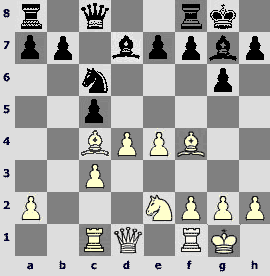
13...a6. Another expert on Gruenfeld defense, Alexander Huzman, used to play 13...¦d8.
14.Јd2 b5 15.Ґd3 Јb7. Another idea was to retain the dark-squared bishops– 15...¦d8!? 16.Ґh6 Ґh8!?
16.Ґh6 Ґxh6 17.Јxh6 cxd4. Immediate 17...Јb6 won't do: 18.¤f4 cxd4 19.e5!, and White obtains a strong attack. Also possible is17...Јa7, and the white advantage is not great at all.
18.cxd4 Јb6? A tactical oversight, after 18...Јa7 19.¦fd1 ¦ac8 the black position is quite normal.
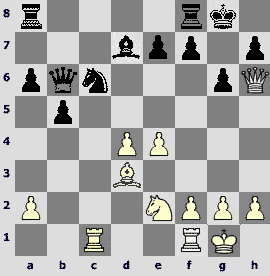
19.¦c5 Ґg4? The previous mistake has upset Peter, and he looses straight off. 19...e5 20.¦fc1 f6 permits to keep the resistance.
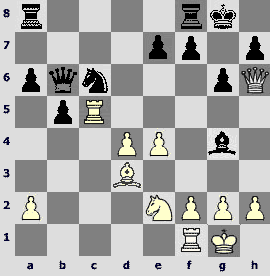
20.¤f4! ¤xd4 21.¦g5 Ґf3 22.¦g3 1–0
V.Topalov (2783) – V.Kramnik (2766) [D37]
1.d4 ¤f6 2.c4 e6 3.¤f3 d5 4.¤c3 Ґe7 5.Ґf4 0–0 6.e3 c5 7.dxc5 Ґxc5 8.Јc2 ¤c6 9.a3 Јa5 10.0–0–0 Ґe7 11.h4 ¦d8 12.¤d2 dxc4 13.¤xc4 ¦xd1+ 14.Јxd1 Јd8 15.Јxd8+ ¤xd8. Straight from the opening the game is transposed into an endgame, which is slightly more pleasant for White. All this is well known in theory.
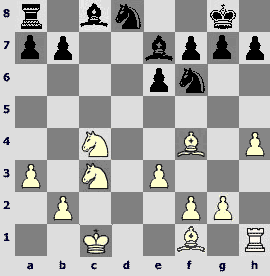
16.Ґe2 Ґd7 17.e4 Ґc6 18.f3 ¤h5

19.Ґc7! White draws the black rook out on c8, which would allow him to win a tempo later on.
19...¦c8 20.Ґe5 Ґf6 21.¤d6 ¦a8 22.Ґxf6 ¤xf6 23.¦d1 ўf8
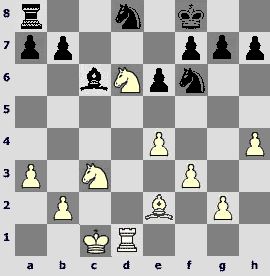
24.ўd2?! A non-characteristic for Topalov, somewhat academic decision; it would be better to begin play on the Q-side immediately – 24.b4!
24...¤e8 25.¤c4. White has a spatial advantage, so he is not willing to exchange pieces.
25...f6 26.ўe3 b6 27.f4 ¤f7 28.g4 h6
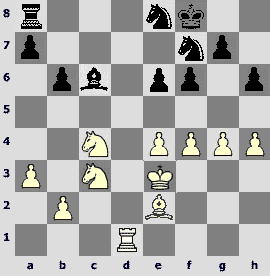
29.g5! hxg5 30.hxg5 ўe7 [bad is 30...fxg5 31.fxg5 ¤xg5 32.¤e5] 31.gxf6+. To capture still more space is no good here, the pawn on g6 would have become a weakness: 31.g6 ¤fd6 32.e5 ¤f5+ 33.ўf2 ¤h4 34.¦g1 ¦d8 35.exf6+?! ¤xf6 36.¤e5 Ґb7, and now it is White who has to care about equality.
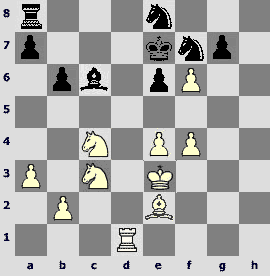
31...¤xf6!! A brilliant move, permitting Black to hold his own confidently; after "mechanical" 31...gxf6 32.¦h1 Black is in trouble.
32.¦g1 ¦g8 33.¦g6
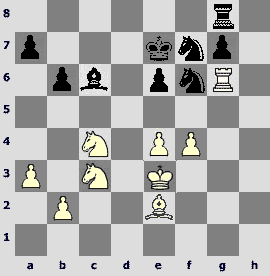
33...Ґb7! Avoiding 33...¤h8 34.¦g5 ¤f7 35.¤e5! ¤xe5 36.¦xe5 ¦h8 37.¦g5, and the king on f7 is both under an attack of c4-bishop and threatened by f4-f5, thus Black is still in trouble.
34.a4 ¤h8 35.¦g1 ¤f7 36.a5 g5! Lack of material permits Black not to worry; he can even, as the last resort, give up a pawn.
37.fxg5 ¦xg5 38.¦xg5 ¤xg5 39.e5 ¤d7 40.¤d6
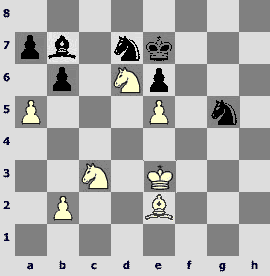
40...Ґf3! 41.axb6 axb6 42.Ґxf3 ¤xf3 43.¤c8+ ўd8 44.ўxf3 ¤xe5+ 45.ўe4 ¤c4 46.ўd4 ¤xb2 47.¤xb6 ўc7 48.¤c4 ¤xc4 49.ўxc4 Ѕ–Ѕ . Vladimir Kramnik carried out the defense of an unpleasant ending brilliantly.
A.Motylev (2647) – T.Radjabov (2729) [E92]
1.d4 ¤f6 2.c4 g6 3.¤c3 Ґg7 4.e4 d6 5.¤f3 0–0 6.Ґe2 e5 7.Ґe3 ¤g4 8.Ґg5 f6 9.Ґh4 g5 10.Ґg3 ¤h6 11.dxe5 dxe5 12.Јd5+ ўh8 13.0–0–0 Јe7 14.Јa5 c6 15.¤d2
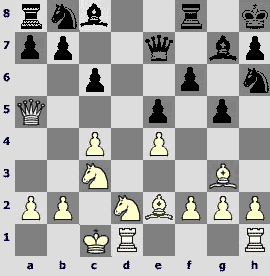
15...b6! 16.Јa4 Ґd7 17.f3 c5. Usually in King's Indian defense the white knight aiming at d5 is stronger than the black one which heads for d4. But here we have an exception; the chances are approximately even.
18.Јa3 ¤c6 19.¤d5 Јf7 20.Ґd3 Ґe6 21.h3 f5 22.¤b1 ¤d4 23.¤bc3 ¦fd8 24.Ґe1 f4 25.ўb1

25...¤g8! The knight on h6 was not exactly an asset.
26.¤e2 ¤e7 27.¤xd4 exd4 28.h4 g4 29.¤c7?! The handsome knight leaves the important square on its own free will; there's something wrong there! And the right way is 29.Ґd2 Ґe5 30.fxg4 Ґxg4 31.¦df1 ¤xd5 32.exd5 with complex struggle.
29...¦ac8. A very interesting position could have been obtained after 29...Ґxc4 30.Ґxc4 Јxc4 31.¤xa8 ¦xa8 32.fxg4 ¤c6, but to offer an exchange without any grim necessity is not easy.
30.¤xe6 Јxe6 31.Ґd2 gxf3 32.gxf3 ¤c6
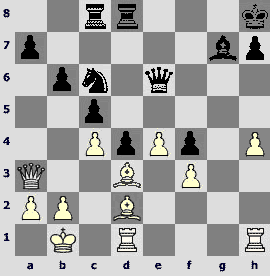
33.Ґxf4? Looks like time pressure. After 33.¦dg1 ¦f8 Black, in all probability, has an advantage, but there is "whole lotta" struggle ahead.
33...¦f8 34.Ґc1 ¦xf3 35.¦hg1 ¤b4 36.Јxa7 ¦g8 37.Јa3 b5 38.e5 ¦xd3 39.¦xd3 Јf5 40.¦g5 0–1
S.Tiviakov (2667) – V.Anand (2779) [B17]
1.e4 c6 2.d4 d5 3.¤d2 dxe4 4.¤xe4 ¤d7 5.¤f3 ¤gf6 6.¤xf6+ ¤xf6 7.Ґc4 Ґf5 8.Јe2 e6 9.c3 Ґe7 10.¤e5 ¤d7 11.Ґf4 ¤xe5 12.Ґxe5 Ґf6 13.¦d1 0–0 14.0–0 h6 15.¦fe1 Јe7 16.Јf3 ¦fd8 17.Јg3 ¦d7 18.Ґxf6 Јxf6 19.¦e5 a5 20.¦de1 ўh8 21.h3 b6 22.a3 Ґh7 23.¦1e3 ¦c8 24.¦f3 Јe7 25.Јg4 Јd6 26.¦g3 ¦g8 27.Јh5 Ѕ–Ѕ

Supposing that the opponents have changed their places, it would be interesting to watch the further game. I think that black position is objectively dangerous. White can prepare his attack on the K-side by advancing the f- and g-pawns. Surely Black is not going to sit and wait for a checkmate, and when White leaves his rear lines unprotected, he will carry out c6-c5. The only question is, will he have enough time for his counterplay? In the game Sergei decided to do just nothing and simply offered a draw.
A.Shirov (2715) – L.Aronian (2744) [C88]
1.e4 e5 2.¤f3 ¤c6 3.Ґb5 a6 4.Ґa4 ¤f6 5.0–0 Ґe7 6.¦e1 b5 7.Ґb3 0–0 8.h3 Ґb7 9.d3 d6 10.a3 ¤a5 11.Ґa2 c5 12.¤c3 ¤c6 13.¤d5 ¤xd5 14.Ґxd5 Јc7 15.c3 ¤b8 16.Ґxb7 Јxb7 17.¤h2. Routine d3-d4, that has been tested more than once before, fails to bring any advantage, so Alexey takes another road.
17...¤d7 18.¤g4 ¤f6 19.¤e3 g6 20.b3 ¦ab8 21.Ґb2?! ¦fd8 22.Јf3 d5 23.exd5 ¤xd5 24.d4 ¤f4 25.Јg3. 25.Јxb7 ¦xb7 26.dxe5 ¤d3 27.¦e2 Ґg5 leads to a dangerous ending for White.
25...¤d3
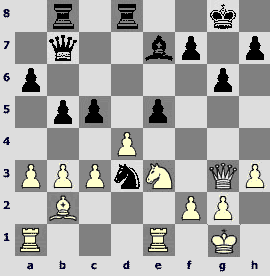
26.¤g4?! Quite possibly 26.¤f5 is more preferable, although Black already possesses an advantage.
26...e4! Black acquires a decisive advantage, and White's practical chances for a salvation are pretty miserable.
27.d5!? Јxd5 28.c4 Јe6 29.Ґe5
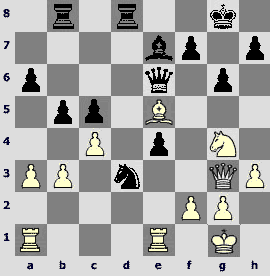
29...Ґd6! The most skillful decision. 30.Ґxd6 Јxd6 31.¤h6+ ўf8 32.¦xe4 Јxg3 33.fxg3 bxc4 34.bxc4 ¦d4? An easy way to win would be 34...f5 35.¦f1 ўg7 36.¤xf5+ gxf5 37.¦xf5 ¦d7.
35.¦xd4 cxd4 36.¤g4 h5 37.¤f2 ¤e5 38.c5 ¦b3 39.g4 ўe7 40.gxh5 gxh5 41.¤e4. Black's advantage is as before great bordering on decisive, but to win is already not so simple.
41...¦e3 42.¤d6 ўe6 43.¤e8 a5 44.¤c7+ ўf5 45.¤b5 ўe4 46.¦d1 ¤c6 47.ўf2
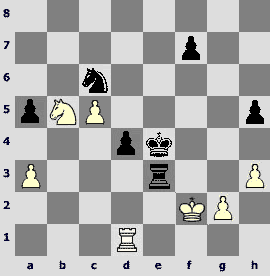
47...a4? Levon gets careless, it's been necessary to carry out 47...¦b3 48.a4 ўd5, and Black is close to a victory.
48.¤d6+ ўd5
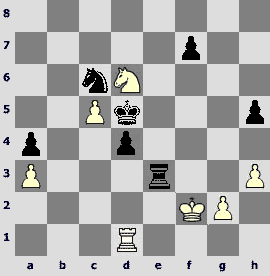
49.¦xd4+! ўxd4 50.¤f5+ ўxc5 51.ўxe3 ¤e5
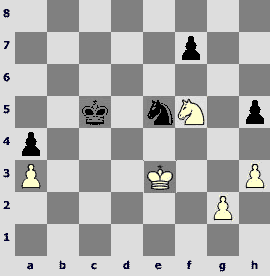
52.g4! Not only the most spectacular, but also the most accurate way to a draw.
52...hxg4 53.h4 ўc4 54.h5 ўb3 55.ўd4! Exactly so! I have no slightest doubt that Alexey has seen it all while making his 52nd move.
55...¤f3+ 56.ўd3 ўxa3 57.ўc3 Ѕ–Ѕ. The most elegant salvation!
